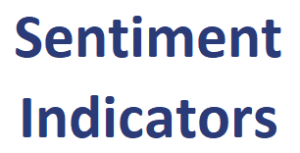Sentiment Indicators
Sentiment indicators are measures of sentiment and capital flows that are used to gain insight into potential emerging trends in financial markets. Sentiment indicators can be used to infer the views of potential buyers and sellers.
Market sentiment is said to be bullish when investors expect increasing prices and bearish when investors expect decreasing prices.
On this page, we discuss several popular sentiment indicators that professional investors use.
- Margin debt. The amount of margin debt is a readily available indicator because brokers are required to report it to regulators. Increases in total margin debt outstanding imply aggressive buying by bullish maring investors. As margin investors reach their limits of margin credit, their ability to continue buying decreases. In that case, prices may start to decline. As prices decrease, investors may need to sell securities to meet margin calls. When this in turn leads to newe margin calls, this vicious circle is referred to as a fire sale.
- Short interest ratio. Just as an increase in margin debt suggests aggressive buying and strong positive sentiment, increases in shares sold indicate strong negative sentiment. Short interest is the number of shares investors have borrowed and sold short. The short interest ratio is short interest divided by average daily trading volume (ADV).
- The Arms index or short-term trading index (TRIN) is a measure of funds flowing into advancing and declining stocks. A value close to 1 suggests funds are flowing about evenly. Values greater than one mean most of the volume is in declining stocks, while an index less than one means more of the volume is in advancing stocks.
Summary
We discussed a number of popular non-price-based sentiment indicators used by professional investors to measure investor sentiment, which can be bullish or bearish.

